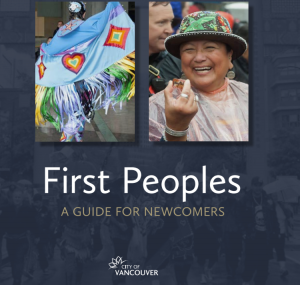The city of Vancouver has various documents that outline many of the resources and services that can be found in Vancouver. From Parks and Recreation to City Council to Housing to Businesses, there is a wide gamut of information available. This booklet was developed by the city of Vancouver for new immigrants and people new to Canada.
While I don’t know the second author, Jane Henderson, I am familiar with Kori Wilson. Kori is an Indigenous lawyer living on the Musqeum reserve in Vancouver. She has a wealth of knowledge about many things Indigenous, the colonizer history in British Columbia and Canada and has family members who are residential school survivors. She knows what she is talking about, and I am glad that she authored this booklet with the City of Vancouver, so it is imbued with her Indigenous perspective. It is informative, though I’m not sure how the information is received by newcomers to BC. It is a pdf document buried on the City of Vancouver website, and is not immediately apparent when looking at the website. It should be featured more prominently on the website and be easier to access. You have to have a certain amount of knowledge to be able to research (in English) and find the document on the website. There is also the literacy factor that requires a certain level of reading and comprehension, again in English, to understand the information presented. There is a great ‘myths vs facts’ section, but again, if it’s not accessible on the website, the information gets lost.
It is an interesting read, for sure!
Wilson, K., & Henderson, J. (2013, March 3). First peoples: A guide for newcomers. Vancouver.Ca. https://vancouver.ca/files/cov/First-Peoples-A-Guide-for-Newcomers.pdf

